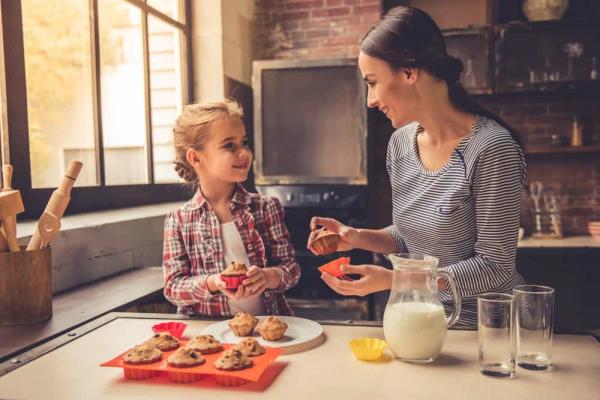
Bringing your children into the kitchen is a recipe for fun and learning. It's a great excuse for one-on-one time that doesn't involve electronics or other distractions. Not only do you get the chance to cook up some great memories, your children also develop confidence and lifelong skills.
As a professional organizer, it's been a delight to help families make simple changes that turn the kitchen into a fun spot to be together. Planning ahead and organizing your kitchen with your kids in mind can help create a space everyone can safely use. Try these tips in your own kitchen:
Rethink organization
Chefs use a technique called mise en place, which is a French term for putting everything in its place. It usually applies to getting everything ready for a recipe before starting to cook. But for your kids, mise en place means getting your kitchen ready before jumping into a project with your little ones.
Early in your child's life, your kitchen was arranged to be convenient as you filled their bottles and made their meals. When your child is old enough to be invited to help cook, it is time to change things a bit. You'll want to keep hazardous items out of the way or behind child-proof locks, but other things should stay within their reach. Here are some organization tips:
-
Use a lower drawer or cabinet to hold children's dishes and cups. This way they can set their own place at the table.
-
Place healthy snacks on a shelf in the pantry where they can reach.
-
Clear off an area of the island or countertop away from the stove so there is a safe space for your child to work.
-
It can be fun for your child to have a few of their own kitchen tools. A set of plastic measuring cups and spoons, a scraper, a wooden spoon and a durable bowl are some good early tools. Organize them in a lower cabinet so your child can reach them.
Establish firm safety rules
Firm rules will help keep child safe in the kitchen. These may include only working in the kitchen with an adult, asking permission first, not ever touching the stove or oven and not ever handling sharp knives or other dangerous items.
Invest in a sturdy stepstool with good grips on the bottom so it won't easily slide while your children stands on top to help. Avoid having your child stand on a chair or sit on the kitchen countertop, as it could result in a dangerous fall.
Part of kitchen safety is teaching healthy habits. Start all cooking or kitchen tasks by having your child wash their hands. In addition, remind them to not touch their face while cooking, or eat raw food without asking you first.
Cook up some fun
Making yummy treats like cookies or brownies are often one of the earliest tasks we invite children to help us with. However, keep in mind that helping in the kitchen can also introduce your child to healthy fruits and vegetables. Having your kids add ingredients to a dish might just entice them to try a new food at dinner.
Get your child involved by letting them measure and stir. Here are just a few ideas for tasks children may enjoy doing that don't involve a stove or oven:
-
Crack an egg and whisk it in a bowl for a recipe.
-
Rinse fruits and vegetables.
-
Add ingredients to a salad; let them toss the salad before serving.
-
Pour pre-measured ingredients into a bowl. Older children will enjoy measuring the ingredients themselves.
-
Make a sandwich.
-
Butter toast.
-
Juice a lemon with a hand juicer.
-
Cut soft food with a plastic knife. For example, they could cut a banana into rounds for a smoothie.
-
Spread peanut butter on apple slices.
Clean fun
Instead of telling your little chef doing dishes is a chore, show them how fun washing dishes in soapy water is! Having them help wash dishes and clean surfaces is a great way to end a cooking project (and clean your kitchen at the same time).
Cooking with children can be a bit messier than cooking alone, but the one-on-one time and lessons learned make it worthwhile. You can make it easier to clean up with some of these organizing tips:
-
Fill a sink of warm, soapy water. As you finish with a bowl or spoon, have your child drop it in the sink to soak.
-
Teach children to carry their own dirty dishes to the sink.
-
Have them help unload the dishwasher.
-
If your child is mixing something, place a rimmed baking sheet under their bowl. If flour flies out or liquid spills, the sheet will catch most of the mess, making clean up much easier.
-
Not being able to reach makes kids more prone to spills, so let them use a sturdy step stool.
-
Place some warm, soapy water in a small squirt bottle. Let your child squirt the counter and clean it with a sponge.
Helping to make your kitchen a warm, loving environment for learning will pay off in so many ways. Don't hesitate to bring your kids into the kitchen to teach them lessons and make memories.

